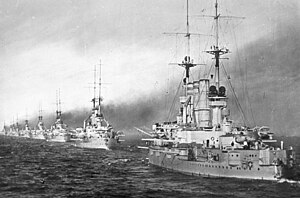
Back بارجة فئة دويتشلاند Arabic Třída Deutschland (1904) Czech Deutschland-Klasse (1906) German Clase Deutschland (1904) Spanish نبردناو کلاس دویچلند Persian Deutschland-luokka (1904) Finnish Classe Deutschland (cuirassé) French אוניות המערכה מסדרת דויטשלנד (1904) HE Deutschland osztály (csatahajók) Hungarian Classe Deutschland (nave da battaglia) Italian
 Deutschland-class battleships in line[a]
| |
| Class overview | |
|---|---|
| Builders | |
| Operators | |
| Preceded by | Braunschweig class |
| Succeeded by | Nassau class |
| Built | 1903–1908 |
| In commission | 1906–1945 |
| Completed | 5 |
| Lost | 3 |
| Scrapped | 2 |
| General characteristics | |
| Type | Pre-dreadnought battleship |
| Displacement | |
| Length | Overall length: 127.6 m (418 ft 8 in) |
| Beam | 22.2 m (72 ft 10 in) |
| Draft | 8.21 m (26 ft 11 in) |
| Installed power | |
| Propulsion |
|
| Speed | 18.5 to 19.1 knots (34.3 to 35.4 km/h; 21.3 to 22.0 mph) |
| Range | 4,800 nmi (8,900 km; 5,500 mi); 10 knots (19 km/h; 12 mph) |
| Complement |
|
| Armament |
|
| Armor | |
The Deutschland class was a group of five pre-dreadnought battleships built for the German Kaiserliche Marine (Imperial Navy), the last vessels of that type to be built in Germany. The class comprised Deutschland, the lead ship, Hannover, Pommern, Schlesien, and Schleswig-Holstein. The ships closely resembled those of the preceding Braunschweig class, but with stronger armor and a rearranged secondary battery. Built between 1903 and 1908, they were completed after the launch of the revolutionary British all-big-gun battleship HMS Dreadnought in 1906. As a result, they were obsolescent before entering service. The ships nevertheless saw extensive service in the High Seas Fleet, Germany's primary naval formation, through the late 1900s and early 1910s, when they were used for training, which included overseas cruises.
Following the start of World War I in July 1914, the German fleet adopted a strategy of raids on the British coast, which the five Deutschland-class ships supported. These operations culminated in the Battle of Jutland on 31 May – 1 June 1916, where all five ships saw action, despite their marked inferiority to British dreadnoughts. Regardless, they intervened to protect the battered German battlecruisers from their British counterparts, allowing them to escape. In the confused night actions, Pommern was torpedoed and sunk by a British destroyer. After the battle, the four surviving ships were removed from front-line service and used for coastal defense through mid-1917. Thereafter, Hannover alone remained on patrol duty, while the rest were used as barracks or training ships. After Germany's defeat, the Treaty of Versailles permitted the postwar navy to retain several old battleships for coastal defense, including the four Deutschland-class ships.
Deutschland was broken up in 1920–1922, but the remainder were modernized and returned to active service in the mid-1920s. Their activities mirrored those of the pre-war period, including overseas training cruises and extensive fleet maneuvers. Hannover was decommissioned in 1931 and was to be converted into a target vessel, although this was never done. She was eventually broken up in 1944–1946. Schlesien and Schleswig-Holstein remained in service for training duties through the 1930s into the Nazi-era Kriegsmarine (War Navy). Both ships saw limited duty during World War II, including bombardment of Polish forces during the invasion of Poland in September 1939 and the occupation of Denmark and invasion of Norway in April 1940. Both ships were sunk near the end of the war.
Cite error: There are <ref group=lower-alpha> tags or {{efn}} templates on this page, but the references will not show without a {{reflist|group=lower-alpha}} template or {{notelist}} template (see the help page).
© MMXXIII Rich X Search. We shall prevail. All rights reserved. Rich X Search